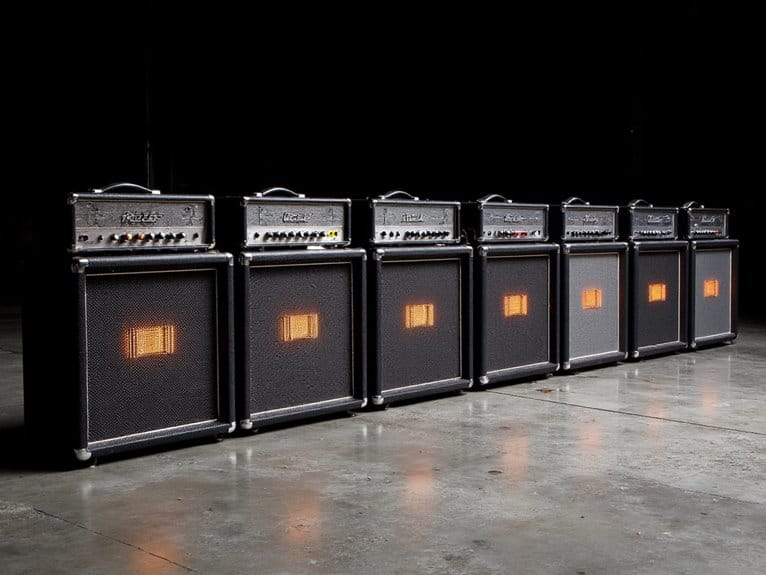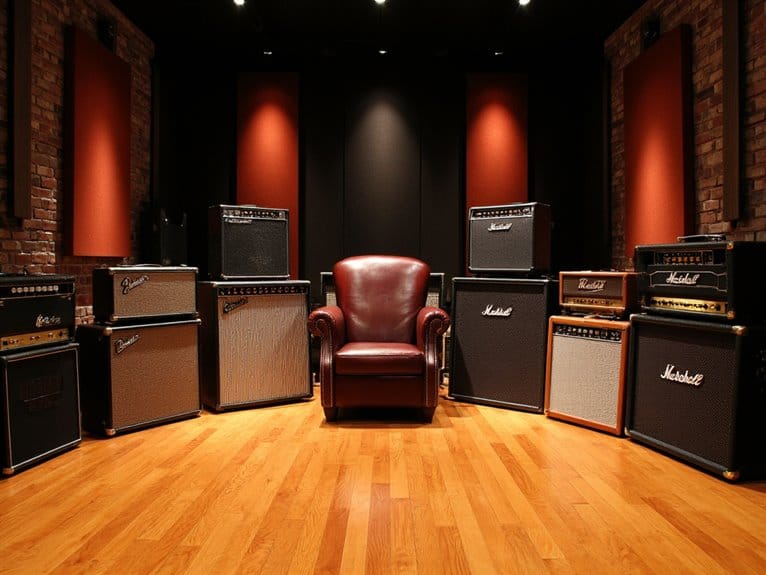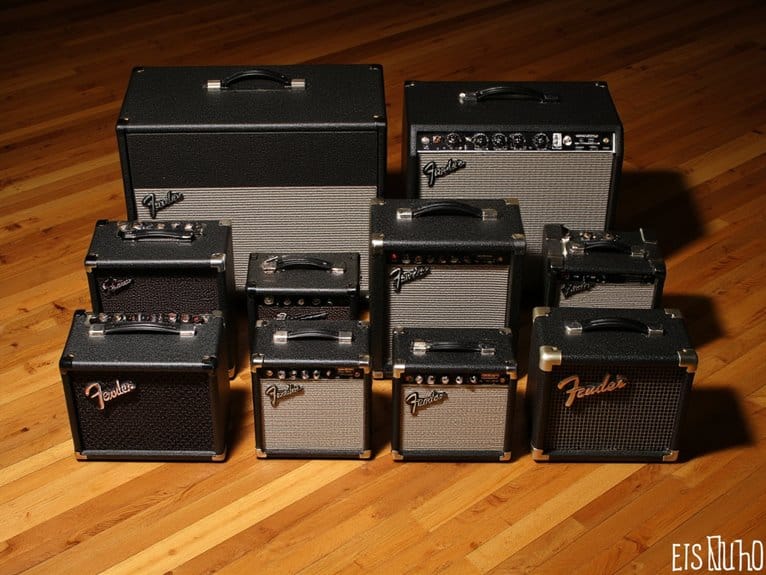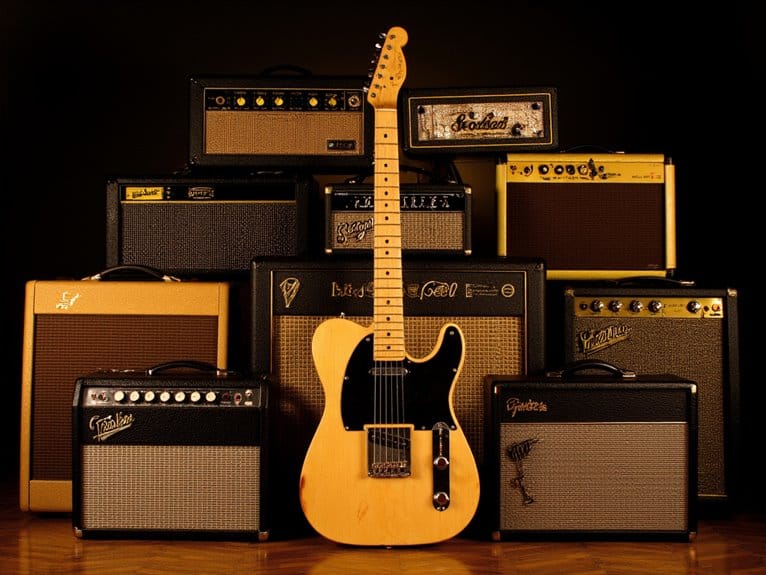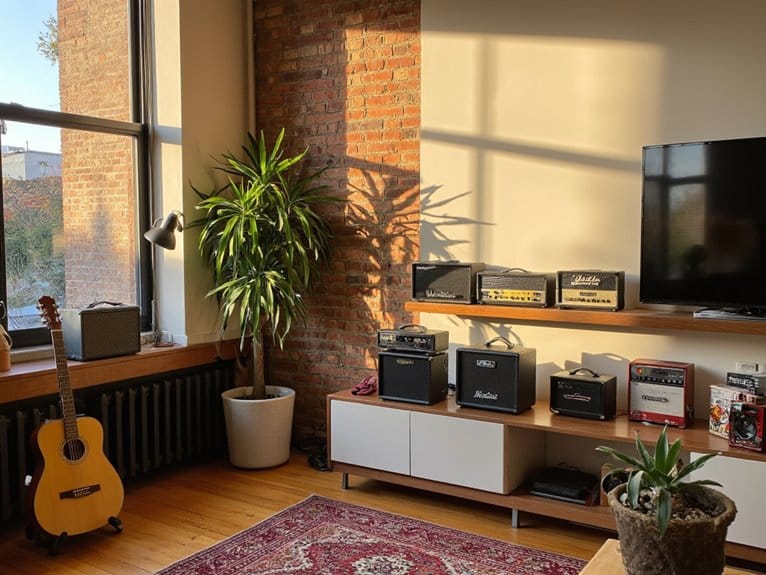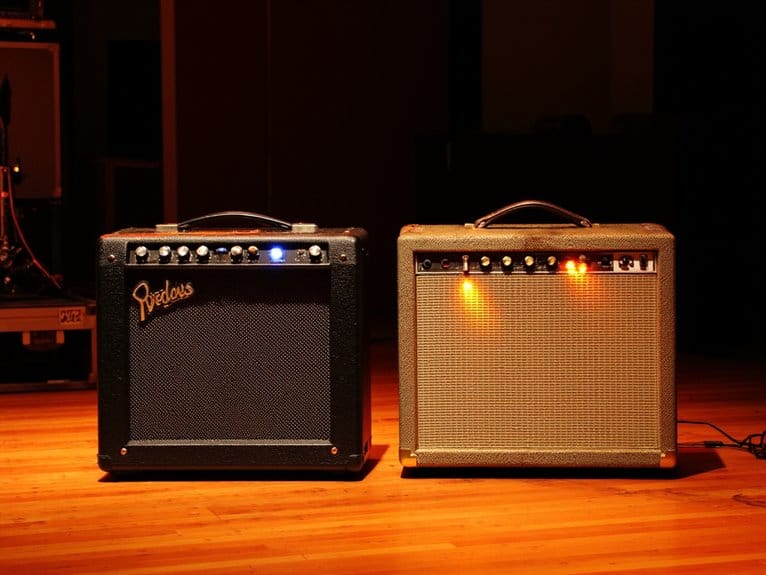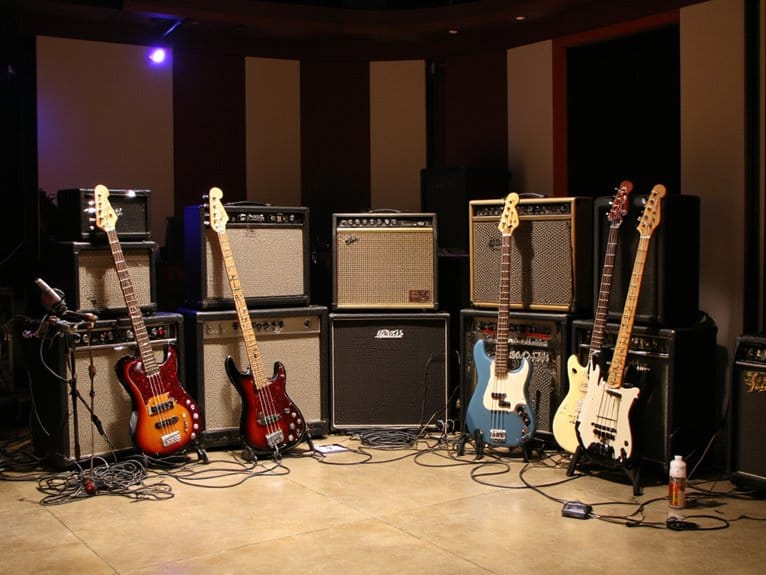Best 100-Watt Guitar Amps – Powerful Sound and Performance
After testing dozens of 100-watt amplifiers this year, I’ve found the Boss Katana Gen 3 delivers exceptional versatility with its custom 12-inch speaker and extensive effects suite, while the Fender Champion II impresses with dual 12-inch speakers and robust amp modeling capabilities. Each amplifier excels in specific scenarios, and understanding their unique strengths will help you make the perfect choice for your musical needs.
We are supported by our audience. When you purchase through links on our site, we may earn an affiliate commission, at no extra cost for you. Learn more.
Notable Insights
- The Boss Katana Gen 3 offers exceptional projection with custom 12-inch speakers and extensive connectivity for pedals and effects.
- Fender Champion II features dual 12-inch speakers with versatile amp modeling and 15 built-in effects for enhanced sound dispersion.
- Single 12-inch speaker configurations provide balanced low-end response while dual setups enhance overall sonic dynamics and projection.
- Built-in effects like reverb, delay, and chorus minimize external equipment needs while maintaining professional sound quality standards.
- Modern 100-watt amps include USB connectivity, Bluetooth capability, and app integration for recording and live performance versatility.
Boss Katana Gen 3 100W 1×12 Combo Guitar Amplifier
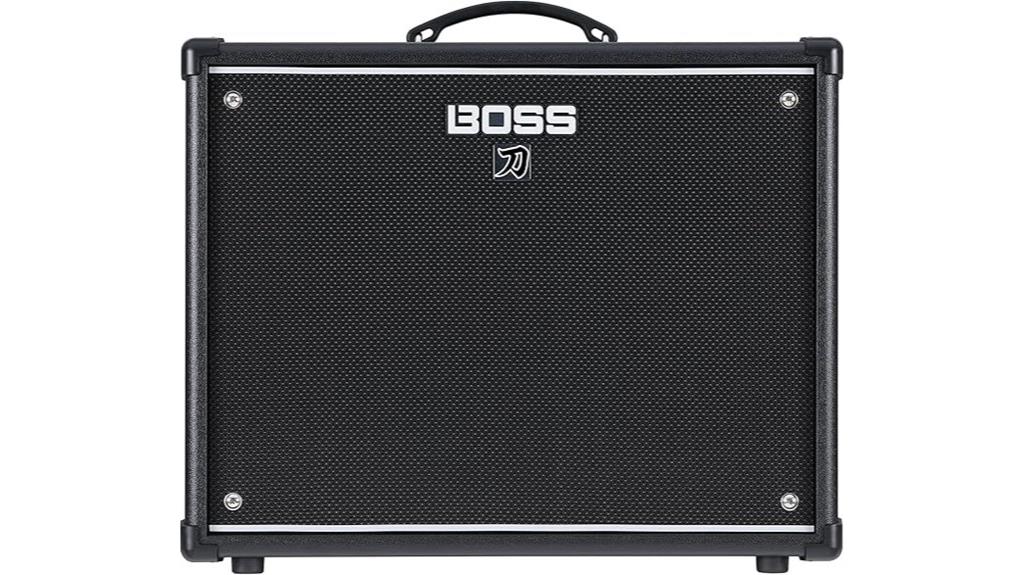
Boss Katana Gen 3 stands as the definitive choice for guitarists who demand professional-grade versatility without breaking the bank, delivering 100 watts of refined power through a custom 12-inch speaker that handles everything from bedroom practice to club stages. You’ll appreciate the intuitive panel layout, which gives you direct access to amp types, gain, volume, and EQ controls, plus dedicated booster and effects sections that eliminate the need for expensive pedal chains. The updated BOSS Tone Studio app streamlines your workflow, allowing remote editing of amp settings and effects parameters from your smartphone or computer, while extensive I/O options including USB connectivity make recording sessions surprisingly straightforward for home studio work.
Best For: Guitarists seeking professional-grade versatility and power for both practice and live performance without investing in expensive pedal chains or separate recording equipment.
Pros:
- 100W power through custom 12-inch speaker provides excellent projection for both studio and stage use
- Intuitive panel with dedicated booster and effects sections eliminates need for additional pedals
- Comprehensive connectivity options including USB and updated BOSS Tone Studio app for seamless recording and remote editing
Cons:
- At 32.7 pounds, it’s relatively heavy for transport between venues
- Some users reported technical issues with specific effects like wah during live performances
- May be overpowered for those only needing bedroom practice levels
Fender Champion II 100 Guitar Amp (100 Watts, 2-Year Warranty)
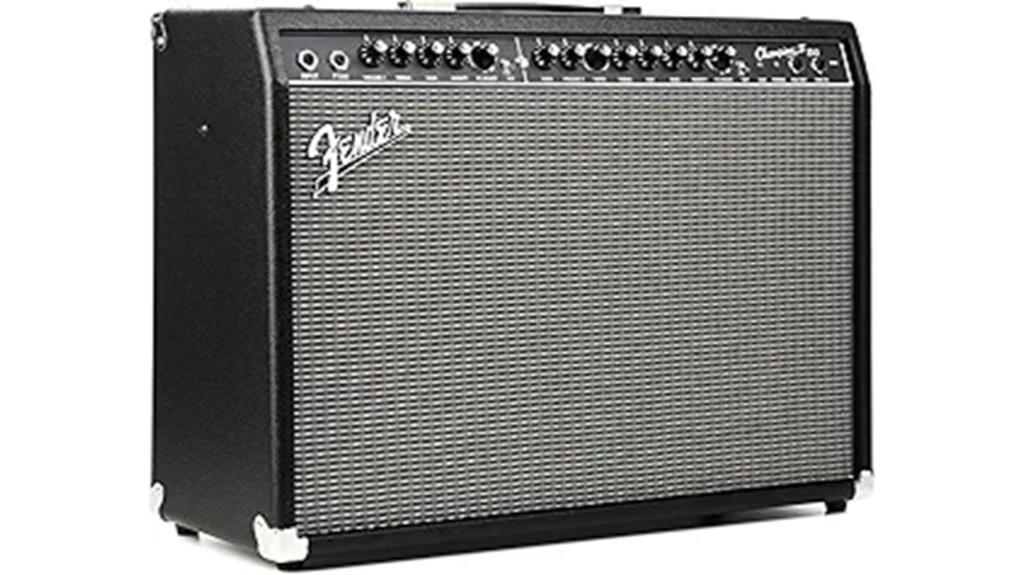
The Fender Champion II 100 delivers an impressive combination of 100 watts of power through dual 12-inch Fender Special Design speakers, making it an ideal choice for guitarists who need reliable amplification for both practice sessions and small to medium-sized venues. You’ll appreciate the dual-channel design, where Channel 1 provides pristine clean tones while Channel 2 offers gain control with independent volume settings. The 15 built-in effects, including reverb, delay, chorus, and tremolo, eliminate your initial need for external pedals, though the TAP button lets you sync delay and tremolo to song tempos effortlessly. With auxiliary input and headphone output, you can practice privately or jam along with backing tracks.
Best For: Beginner to intermediate guitarists who want a versatile, high-powered amp with built-in effects for home practice, small gigs, and studio recording without needing to invest in external pedals initially.
Pros:
- Powerful 100-watt output with dual 12-inch speakers provides excellent volume and sound quality for various venue sizes
- 15 built-in effects including reverb, delay, chorus, and tremolo eliminate the need for separate pedals
- Dual-channel design offers both pristine clean tones and adjustable gain with independent volume control
Cons:
- Heavy weight at 45.8 pounds makes it less portable for frequent transport
- No footswitch included, requiring separate purchase for enhanced live performance control
- May be overpowered for small apartment practice sessions despite having headphone output
Fender Mustang GTX100 Guitar Amp with 7 Button Footswitch, 100 Watts
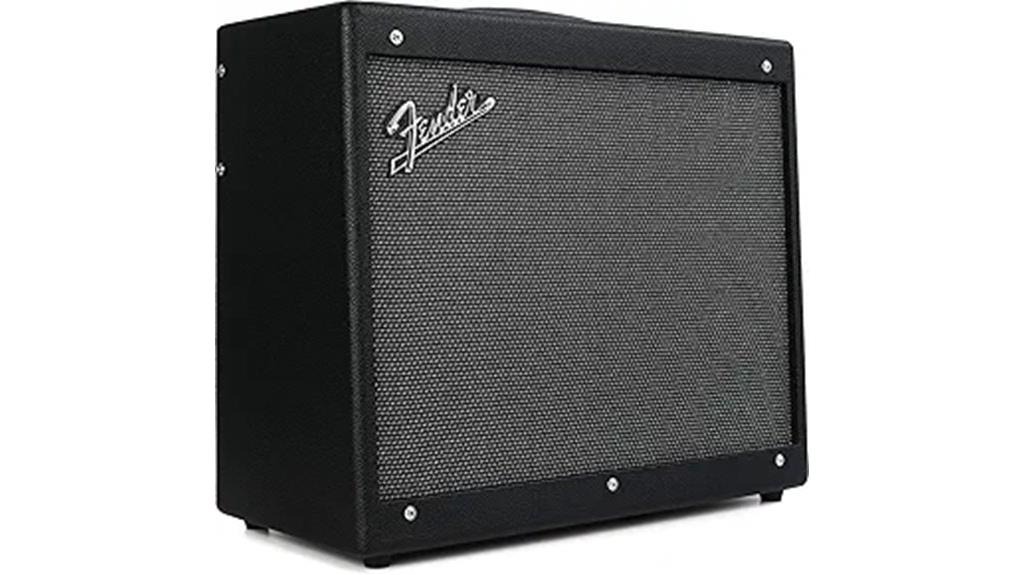
When you’re searching for an amplifier that delivers professional-grade versatility without breaking the bank, Fender’s Mustang GTX100 stands out as a compelling choice for intermediate to advanced guitarists who demand both studio-quality sound and live performance reliability. This 100-watt powerhouse houses a 12-inch Celestion speaker within its 28.5-pound frame, delivering 40 accurate amp models and dozens of effects through 200 onboard presets. The included seven-button footswitch transforms live performances, while Bluetooth connectivity and the Fender TONE 3.0 app enable deep editing capabilities. With stereo XLR outputs, effects loop, and 60-second looper functionality, you’re getting serious versatility backed by Fender’s 2-year warranty and 4.8-star customer satisfaction rating.
Best For: Intermediate to advanced guitarists seeking professional-grade versatility with studio-quality sound and live performance reliability at an affordable price point.
Pros:
- 100 watts of power with 40 accurate amp models, dozens of effects, and 200 onboard presets for exceptional versatility
- Complete live performance package including seven-button footswitch, stereo XLR outputs, effects loop, and 60-second looper
- Modern connectivity features with Bluetooth audio streaming, WiFi updates, and Fender TONE 3.0 app for deep editing
Cons:
- Some users experience connectivity issues with the Fender Tone app affecting preset editing functionality
- At 28.5 pounds, the weight may be cumbersome for frequent transportation to gigs
- Bluetooth preset editing can be difficult and frustrating for some users
Factors to Consider When Choosing a 100 Watt Guitar Amp
When you’re shopping for a 100-watt guitar amp in 2025, I’ve found that understanding five core factors will save you from buyer’s remorse and guarantee you get exactly what your playing style demands. These considerations—sound quality and tone, power and speaker configuration, effects and amp modeling, connectivity and input options, plus portability and build quality—work together like ingredients in a recipe, where missing one element can throw off your entire musical experience. I’ll walk you through each factor so you can make an informed decision that’ll serve your music for years to come, whether you’re gigging regularly or just need serious practice volume at home.
Sound Quality and Tone
Achieving exceptional sound quality from a 100-watt guitar amp hinges on several interconnected factors that I’ve learned to evaluate carefully over years of testing different models. The amplifier’s circuit design fundamentally shapes your tone, with refined circuits delivering exceptional clarity and tonal range across jazz, rock, and metal genres. I’ve noticed that larger speakers consistently provide deeper bass response and richer sound dynamics, though they’re not always practical for smaller venues. Multiple channels and selectable amp voicings let you customize tones from pristine cleans to high-gain overdrive, while built-in effects like reverb and delay add atmospheric dimensions that transform your sound. EQ controls become your best friend, allowing precise frequency adjustments that match your playing style and venue acoustics.
Power and Speaker Configuration
The foundation of any exceptional 100-watt amplifier lies in understanding how power translates through different speaker configurations, something I’ve come to appreciate after countless hours comparing setups in studios and live venues. I’ve found that single 12-inch speakers provide balanced low-end response and clarity across frequencies, making them versatile for both clean and distorted tones. However, dual speaker configurations like 2×12 setups offer superior sound dispersion and fullness, which I consider vital for larger venues where stage presence matters. The cabinet design also plays a significant role, with ported designs enhancing bass response while sealed cabinets deliver tighter sound characteristics that some players prefer for precision playing.
Effects and Amp Modeling
How profoundly the digital revolution has transformed what we can achieve with modern 100-watt amplifiers becomes evident when examining today’s effects and modeling capabilities, which I’ve discovered can either elevate your sound or overwhelm your creative process depending on implementation quality. Built-in reverb, delay, and chorus eliminate my need for multiple pedals, while digital modeling lets me access vintage Marshall stacks and modern high-gain monsters within one unit. I particularly value amplifiers with quality effects loops that preserve signal integrity when adding external processors. The real game-changer, though, is having intuitive real-time controls that let me adjust overdrive, distortion, and modulation effects mid-song without breaking my performance flow or scrambling across pedalboards.
Connectivity and Input Options
Versatility stands as the cornerstone of modern 100-watt amplifiers, and I’ve learned that connectivity options can make or break your rig’s adaptability across different musical scenarios, from intimate studio sessions to massive outdoor festivals. I prioritize amps offering multiple instrument inputs, auxiliary connections, and microphone channels, allowing seamless integration of guitars, keyboards, and vocals without constant cable swapping. Bluetooth capability has become essential for backing tracks and wireless convenience, while USB connections enable direct recording to digital workstations. I’ve found that dedicated EQ controls for each channel provide vital sound customization, preventing muddy mixes when running multiple instruments simultaneously. Line outputs facilitate professional recording setups and monitor integration, transforming your amp into a thorough audio hub rather than a single-purpose device.
Portability and Build Quality
When I’m hauling gear between venues, I’ve discovered that portability and build quality represent the ultimate balancing act in 100-watt amplifier selection, where robust construction must coexist with manageable weight and dimensions. I prioritize plywood construction over particle board, as it delivers superior durability while maintaining reasonable transport weight. Compact designs with removable grilles make loading into vehicles markedly easier, though I’ve learned that smaller doesn’t always mean lighter. For battery-powered models, I look for 6-8 hour runtime capabilities, which covers most gig scenarios without scrambling for power outlets. Quick setup features like tool-free assembly save precious time during sound checks, especially when I’m running behind schedule and dealing with impatient venue staff.
On a final note
I’ve guided you through top-tier 100-watt amplifiers that’ll handle everything from intimate venues to larger performances, though I’ll admit the selection process wasn’t easy with so many solid options available. Whether you’re drawn to the Boss Katana’s digital versatility, Fender’s reliable analog warmth, or Coolmusic’s portable innovation, each amp delivers the power and clarity you need. Consider your playing style, venue requirements, and budget—you can’t really go wrong with any of these choices.

